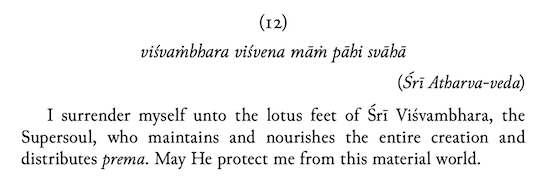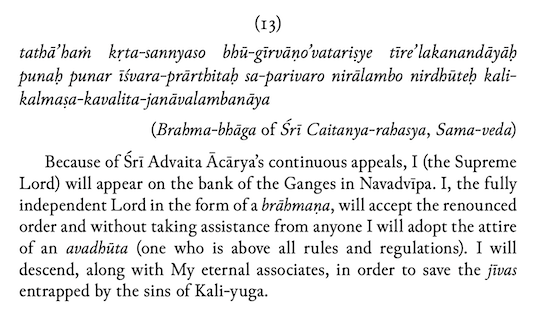Caitanya Mahaprabhu — Scriptural Proofs of His Avatarahood and Divinity. Part 4
 In the thesaurus TITUS of Frankfurt am Main University, among the mantra-s of the Atharvaveda there are indeed these words. For convenience of search I will give a quotation as it is presented in the thesaurus:
v/i/Svambhara v/i/Svena mA bh/arasA pAhi sv/AhA (bAV2, C16, p5)
“Preserve me with all care. O All-Sustainer! All hail to thee!” (transl. by Griffith)
What we have before us is an appeal for protection. There is no predictive flavour in it. Nārāyaṇa Mahārāja has created his translation out of non-existent phrases and ideas in the stanza: “I surrender myself unto the lotus feet of Śrī Viśvambhara, the Supersoul”, “who maintains and nourishes the entire creation and distributes prema”, “May He protect me from this material world”.
There is no “lotus feet” in the stanza, no “I surrender myself”, no “the Supersoul”, much less “who maintains and nourishes the entire creation and distributes prema”, nor “May He protect me from this material world”.
Why are these words considered to be proof of Caitanya’s divinity and a prediction of his descent to the earth? The key word here for the Gauḍīyas is Viśvambhara (“all-sustaining”), the name given to Caitanya by his parents.
In this case, one can only connect the word “Viśvambhara” with Caitanya by taking it out of context. In all the sections of the maṇḍala, including the one in which Viśvambhara is addressed, it is an appeal to the deity(s) for protection. The appeals use a variety of epithets, including Viśvambhara. In the first mantra, Prāṇa and Apāna are asked for protection pr/ANApAnau m.rty/ or mA pAtaM sv/AhA — “Guard me from death, Inhaling and Exhaling! All bliss to you!”.
In the second mantra, the Earth and Heaven are asked for protection: dyā́ vāpṛthivī úpaśrutyā mā pātaṃ svā́ hā: “Guard me from overhearing, Earth and Heaven! All hail to you!”
In the third mantra, the Sun is asked for protection: sū́ rya cákṣuṣā mā pāhi svā́ hā: “Do thou, O Sūrya, with thine eye protect me! All hail to thee!”
According to the Gauḍīya logic, if Caitanya was called Vaiśvānara, then calling to Agni in the Atharvaveda 2.16.4 could be considered a prediction of him:
ágne vaiśvānara víśvair mā deváiḥ pāhi svā́ hā
“Agni Vaiṣvānara, with all Gods preserve me! All hail to thee!”
In the thesaurus TITUS of Frankfurt am Main University, among the mantra-s of the Atharvaveda there are indeed these words. For convenience of search I will give a quotation as it is presented in the thesaurus:
v/i/Svambhara v/i/Svena mA bh/arasA pAhi sv/AhA (bAV2, C16, p5)
“Preserve me with all care. O All-Sustainer! All hail to thee!” (transl. by Griffith)
What we have before us is an appeal for protection. There is no predictive flavour in it. Nārāyaṇa Mahārāja has created his translation out of non-existent phrases and ideas in the stanza: “I surrender myself unto the lotus feet of Śrī Viśvambhara, the Supersoul”, “who maintains and nourishes the entire creation and distributes prema”, “May He protect me from this material world”.
There is no “lotus feet” in the stanza, no “I surrender myself”, no “the Supersoul”, much less “who maintains and nourishes the entire creation and distributes prema”, nor “May He protect me from this material world”.
Why are these words considered to be proof of Caitanya’s divinity and a prediction of his descent to the earth? The key word here for the Gauḍīyas is Viśvambhara (“all-sustaining”), the name given to Caitanya by his parents.
In this case, one can only connect the word “Viśvambhara” with Caitanya by taking it out of context. In all the sections of the maṇḍala, including the one in which Viśvambhara is addressed, it is an appeal to the deity(s) for protection. The appeals use a variety of epithets, including Viśvambhara. In the first mantra, Prāṇa and Apāna are asked for protection pr/ANApAnau m.rty/ or mA pAtaM sv/AhA — “Guard me from death, Inhaling and Exhaling! All bliss to you!”.
In the second mantra, the Earth and Heaven are asked for protection: dyā́ vāpṛthivī úpaśrutyā mā pātaṃ svā́ hā: “Guard me from overhearing, Earth and Heaven! All hail to you!”
In the third mantra, the Sun is asked for protection: sū́ rya cákṣuṣā mā pāhi svā́ hā: “Do thou, O Sūrya, with thine eye protect me! All hail to thee!”
According to the Gauḍīya logic, if Caitanya was called Vaiśvānara, then calling to Agni in the Atharvaveda 2.16.4 could be considered a prediction of him:
ágne vaiśvānara víśvair mā deváiḥ pāhi svā́ hā
“Agni Vaiṣvānara, with all Gods preserve me! All hail to thee!”
 The passage has nothing to do with the Sāmaveda, neither in subject matter, nor in style, nor in language. There are no sections of Caitanya-rahasya and Brahma-bhāga in the Sāmaveda. There is no such kind of passage in the Sāmaveda. Nārāyaṇa Mahārāja could check this without any problem in our age of electronic catalogues and the presence of many Sāmaveda-paṇḍita-s in India, including North India, so to speak, in the Hindi language space that was native to Nārāyaṇa Mahārāja. Was he really trying to convey the truth or was he working for results?
The passage follows the same typical biographical scheme: renunciation – place – epoch – mission (I will accept the renounced order – the bank of the Ganges in Navadvīpa – the age of Kali – save the souls). The passage was created by a follower of Caitanya in the nineteenth and twentieth centuries. The passage was not mentioned by Rūpa, Sanātana, Jīva and subsequent generations until the nineteenth century.
There are no Vedic accents in the passage. There is not a single linguistic feature, not a single verb form, not a single morphological feature typical of the style of the Sāmaveda. In style the passage differs from the style of the Sāmaveda. In the passage itself there are no phrases from the translation: “the Supreme Lord will appear”, “in Navadvīpa because of Śrī Advaita Ācārya’s continuous appeals”, “the fully independent Lord in the form of a brāhmaṇa”. As we can see, the translation contains more than half of Nārāyaṇa Mahārāja’s fantasies inserted into the translation for the sake of persuasion.
The passage has nothing to do with the Sāmaveda, neither in subject matter, nor in style, nor in language. There are no sections of Caitanya-rahasya and Brahma-bhāga in the Sāmaveda. There is no such kind of passage in the Sāmaveda. Nārāyaṇa Mahārāja could check this without any problem in our age of electronic catalogues and the presence of many Sāmaveda-paṇḍita-s in India, including North India, so to speak, in the Hindi language space that was native to Nārāyaṇa Mahārāja. Was he really trying to convey the truth or was he working for results?
The passage follows the same typical biographical scheme: renunciation – place – epoch – mission (I will accept the renounced order – the bank of the Ganges in Navadvīpa – the age of Kali – save the souls). The passage was created by a follower of Caitanya in the nineteenth and twentieth centuries. The passage was not mentioned by Rūpa, Sanātana, Jīva and subsequent generations until the nineteenth century.
There are no Vedic accents in the passage. There is not a single linguistic feature, not a single verb form, not a single morphological feature typical of the style of the Sāmaveda. In style the passage differs from the style of the Sāmaveda. In the passage itself there are no phrases from the translation: “the Supreme Lord will appear”, “in Navadvīpa because of Śrī Advaita Ācārya’s continuous appeals”, “the fully independent Lord in the form of a brāhmaṇa”. As we can see, the translation contains more than half of Nārāyaṇa Mahārāja’s fantasies inserted into the translation for the sake of persuasion.

